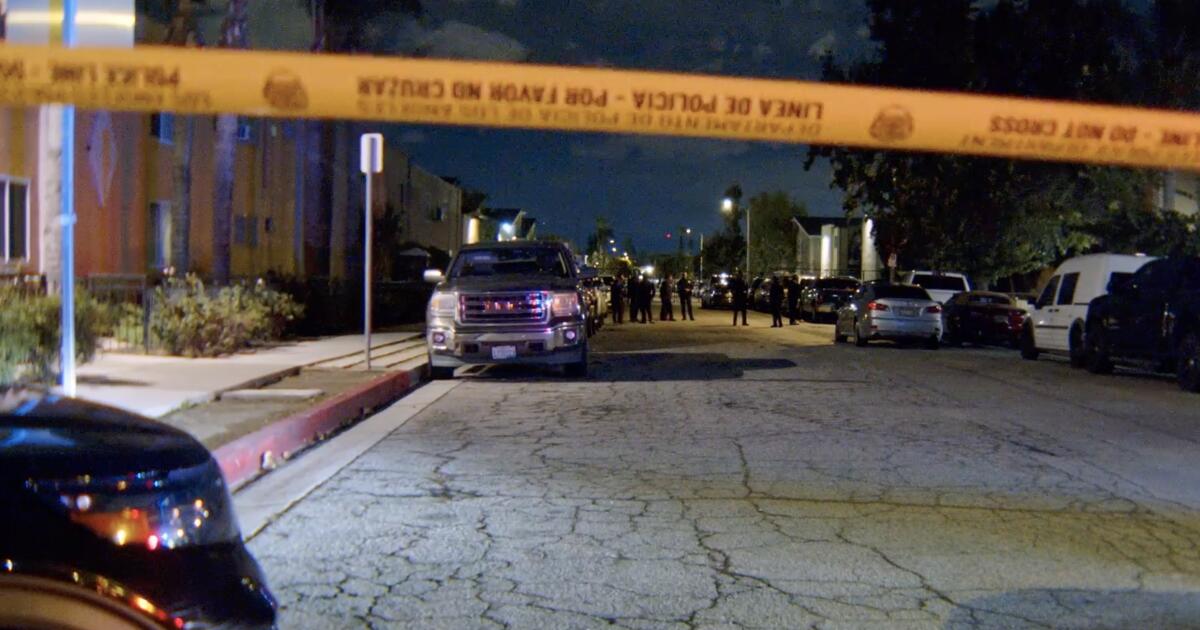A young musician was gunned down. Did childhood friends set her up?
Around 1:30 a.m. on a Saturday last month, two masked men approached a black Cadillac Escalade idling outside a Northridge apartment building.
One held a shotgun, the other a handgun. A surveillance system captured the sounds of what happened next: A gang challenge, confusion, a demand for property.
Then six shots and sounds of the Escalade speeding off.
In the passenger seat was Maria De La Rosa, 22, with a gunshot wound to the chest. A musician who performed as DELAROSA, she had a growing following at the time of her death on Nov. 22.
Authorities said De La Rosa was killed during a robbery but revealed little else about the case. The Times recently reviewed a search warrant affidavit written by the Los Angeles Police Department detective who investigated the homicide. According to the document, De La Rosa was set up by her friends — two of three people now charged with her murder.
Arrested the day after the homicide, Francisco “G Boy” Gaytan told police he’d known De La Rosa since they were teenagers, Det. Siranush Simonyan wrote in the affidavit.
Gaytan said his friend, Benny “Player” Gomez, made plans to meet De La Rosa on Bryant Street for a “drug buy,” but the plan was to rob the musician, the affidavit said.
Gaytan, Gomez and the two alleged gunmen are from Bryant Street, a gang in Northridge, according to the affidavit.
Gaytan claimed he took no part in the robbery, but after he consented to a search of his phone, Simonyan said she found text messages sent to one of the alleged gunmen, Eduardo “Active” Lopez.
“Go get ski mask,” Gaytan allegedly told Lopez five hours before De La Rosa was killed.
Gaytan’s lawyer didn’t return a request for comment.
Gomez was interviewed the day after Gaytan spoke to police, Simonyan wrote. He too said he was “childhood friends” with De La Rosa.
Gomez told detectives he met up with De La Rosa after going to a club. He was talking with her outside Gaytan’s apartment building when two masked men walked up and opened fire. He ducked and ran, he said, and only learned that De La Rosa had been killed when her mother called him.
Gomez insisted he had nothing to do with the shooting. His lawyer didn’t respond to a request for comment.
Gomez’s account was belied by surveillance video, Simonyan wrote. Cameras fixed to a nearby apartment building showed Gomez speaking with Lopez and the second suspected gunman minutes before De La Rosa arrived.
According to the affidavit, Gomez shook their hands and made a Bryant Street hand sign before gesturing for them to walk down an alley, Simonyan wrote.
De La Rosa called Gomez as he walked to greet her, the detective wrote. Meanwhile, the two alleged gunmen approached the Escalade from the alley, pulling a shotgun and handgun from their pants.
“This is Bryant gang, n—,” one said, according to the affidavit.
After De La Rosa was shot and the Escalade sped away, a voice — Gomez’s, detectives suspect — can be heard in surveillance video asking, “Why’d you shoot them, fool?”
After stashing their guns in a Chevrolet Astro van, Lopez and his accomplice got into Gaytan’s BMW 328i, Simonyan wrote. As he stepped into the sedan, the detective wrote, Lopez dropped a key piece of evidence — a court document with his name and case number.
Gaytan appeared to argue with the alleged shooters inside the car, the detective wrote. When he opened his door, surveillance cameras captured him saying, “Get out of here.”
“You fools are dumb,” Gaytan said. According to the affidavit, he could he heard saying what sounded like, “What you fools did — I told you what to make it look like.”
The alleged shooters got out of Gaytan’s car and sped off in a Honda Civic, presumably to Mexico, Simonyan wrote. About 13 hours after De La Rosa died, Gomez allegedly wrote in a text to Gaytan: “We good they left to tj.”
Gaytan and Gomez have yet to enter pleas to charges of murder and attempted robbery. Prosecutors also announced charges against Lopez, but it’s unclear if he’s in custody. Authorities have not said if the second alleged gunman is charged with De La Rosa’s murder, and his whereabouts are unclear.
